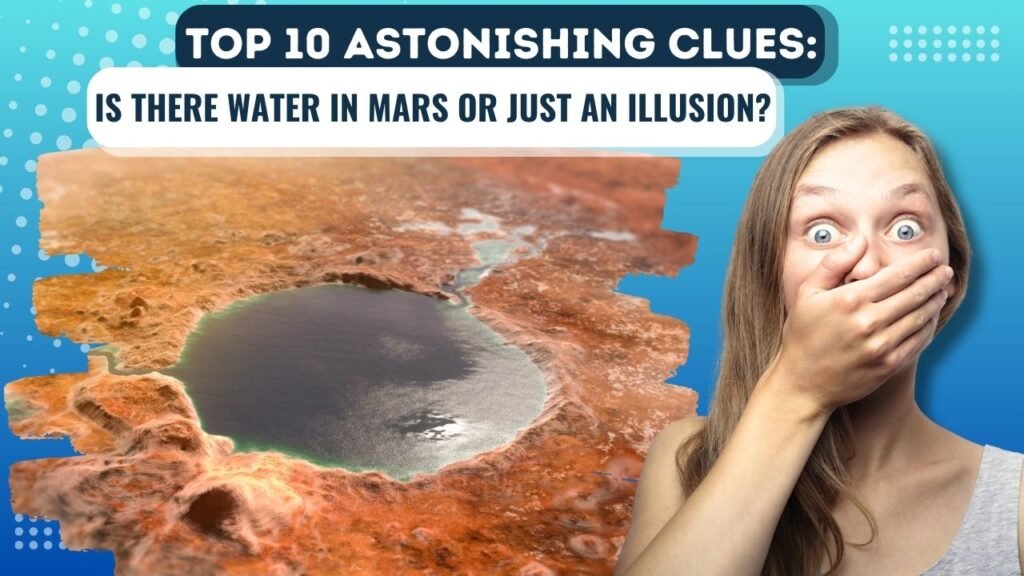
Introduction
Mars, often called the Red Planet, has always fascinated us. For years, scientists have asked the question: is there water in Mars? And the answer could change everything we know about the possibility of life beyond Earth.
Let’s dive into the top 10 clues that may prove whether water on Mars is a reality or just a hopeful illusion.
1. Ice Caps on Mars: A Promising Sign

At Mars’ poles, there are large ice caps similar to the ones we have on Earth. These caps are made of frozen water and carbon dioxide. This is one of the strongest hints that Mars once had, and might still have, water.
- Does This Mean Mars Has Water Today? The ice caps definitely suggest that water Mars was a thing in the past. However, whether there’s liquid water today remains unclear since these ice caps are frozen solid.
2. Signs of Ancient River Valleys
Scientists have observed what look like dried-up riverbeds on Mars. These valleys and channels are a lot like those made by rivers on Earth, which could mean that water once flowed across Mars’ surface.
- Could Water Still Flow on Mars? While these river valleys indicate that Mars had flowing water millions of years ago, it’s unlikely that these rivers are active now. The atmosphere is too thin for liquid water to stay on the surface for long.
You may also like: 10 Mysterious Doors in the World Should Never Be Opened
3. The Mystery of Recurring Slope Lineae (RSL)
RSL are dark streaks that appear and disappear seasonally on Mars’ slopes. Scientists think these streaks could be evidence of salty water briefly flowing down hillsides during warmer months.
- Saltwater or Something Else? Some scientists argue that these streaks might be created by something other than water, like shifting sands. But many believe that salty water could still be involved, keeping the question of is there water in Mars alive.
4. Mars’ Atmosphere and Water Vapor

Mars has a thin atmosphere, but it does contain some water vapor. While it’s not much, this vapor proves that there’s some water activity in the air.
- How Does This Affect the Search for Water? The water vapor suggests that while liquid water may not be common on Mars’ surface, there are still small amounts of water present in the Martian atmosphere.
5. Evidence from Mars’ Polar Regions
The poles of Mars are not just covered in ice—they also hide layers of dust and soil. Radar scans have shown these layers, which might contain buried water ice.
- Why Is This Important for Future Missions? If there’s ice beneath Mars’ surface, it could be a valuable resource for future missions, especially if we plan on sending humans to Mars. Having access to water could make life and exploration much easier.
6. Martian Meteorites and Water Clues
Meteorites from Mars have landed on Earth, and they hold clues about the history of water Mars. Some minerals found in these meteorites could only form in the presence of water.
- What Do Meteorites Tell Us About Mars? These meteorites suggest that Mars had water billions of years ago. While that doesn’t confirm water exists there today, it shows that water has been part of Mars’ story.
7. Frost and Fog on Mars
Although Mars has a thin atmosphere, scientists have observed frost and fog on the planet. This shows there’s some water vapor activity happening, even if it’s limited.
- Does This Mean There’s Water Mars Today? Frost and fog show that there’s moisture in the Martian atmosphere, but it’s not enough to create large bodies of water like oceans or lakes.
You may also like: The Top 10 Mysterious Photos That Science Still Cannot Explain
8. Salty Streaks on the Surface

Mars has salty streaks called briny flows that show up during warm seasons. Some scientists believe these streaks might be signs of water.
- Is Salty Water Flowing on Mars? These salty streaks appear when the planet gets warmer, hinting at some form of liquid water. However, they might just be due to the planet’s salts interacting with the thin atmosphere rather than flowing water.
9. Mars Rover Discoveries (Curiosity and Perseverance)
NASA’s Mars rovers have been exploring and analyzing the surface for years. They’ve found minerals like clay, which can form when water is present.
- What Have the Rovers Found About Water? The rovers have found proof that water once flowed on Mars, especially in ancient lake beds. However, they haven’t yet found liquid water on Mars today.
10. Radar Studies Near Mars’ South Pole
Recently, radar scans have shown signs of what could be liquid water beneath Mars’ south pole ice cap.
- Could Liquid Water Exist Under the Surface? Some scientists are excited by the idea that there could be water trapped under the ice. If true, it’s a big discovery. However, others believe more evidence is needed before we can confirm if liquid water really exists under the surface.
The Ongoing Debate: Is Water Really on Mars?
The evidence for water Mars is there, but scientists are still debating. While some clues, like river valleys and polar ice caps, strongly suggest Mars once had water, others are still uncertain.
- Why Is It So Hard to Confirm Water on Mars? Mars’ environment is extreme, making it challenging for liquid water to exist on the surface. Many of the clues could also be explained by other processes, so more exploration is needed.
What’s Next for Mars Exploration?
To answer the question, is there water in Mars, future missions are being planned. Space agencies like NASA are sending advanced technology to dig deeper into Mars’ surface and study its atmosphere.
- What Could Future Discoveries Mean? Finding water could change everything for human missions. Water is not just crucial for drinking; it can be used to grow food and even create rocket fuel, making it vital for Mars colonization.
Conclusion: Is There Water in Mars or Just a Myth?
Mars has shown us signs of water—ancient river valleys, salty streaks, and ice caps—but confirming that liquid water exists today is still a challenge. The evidence is strong, but we need more proof to say for sure whether water truly flows on Mars now.
Few More Queries
1. How do scientists look for water on Mars?
They use satellites, radar scans, and rovers to search for signs of water in the soil, atmosphere, and beneath the surface.
2. Why is water so important for Mars missions?
Water is necessary for life and can be used for drinking, farming, and making fuel, making it key for future Mars missions.
3. Can humans use water on Mars?
If water ice or underground water is found in large amounts, future missions could use it to support astronauts and exploration.
4. Is the water evidence on Mars reliable?
While the signs are promising, some might be explained by other processes. Scientists need to gather more data to confirm.
5. What’s the next step for space agencies?
New missions are being planned with better technology to explore Mars, aiming to solve the mystery of water once and for all.



